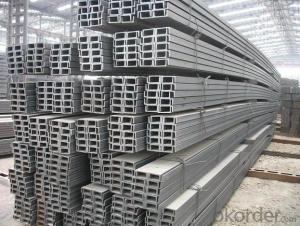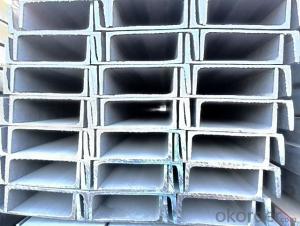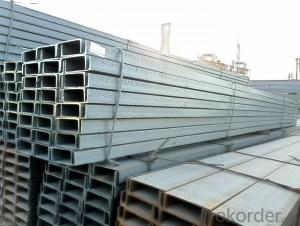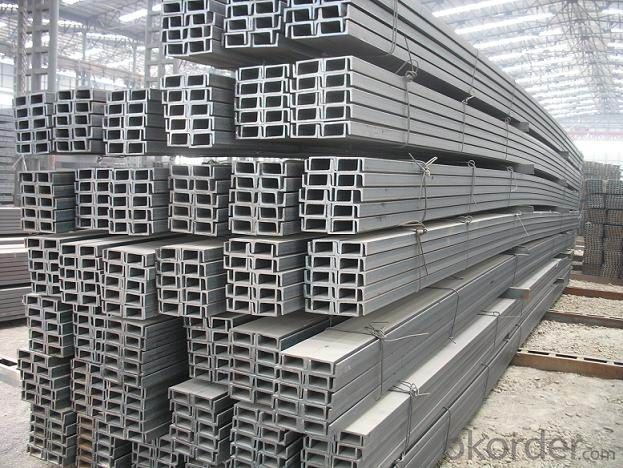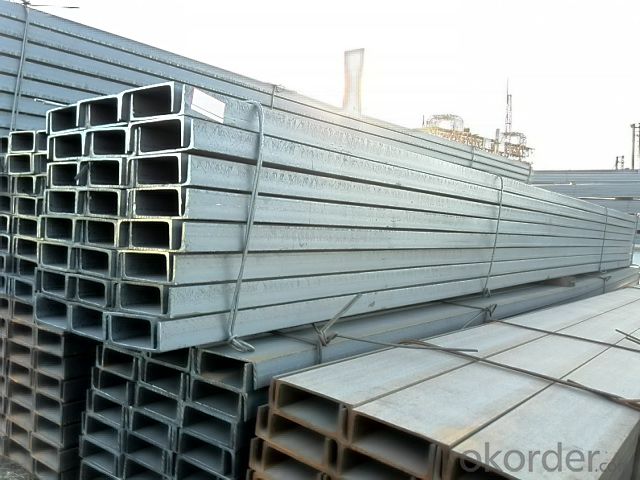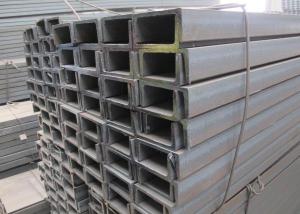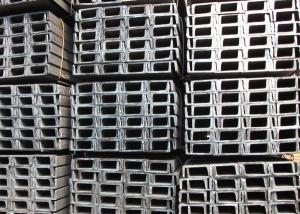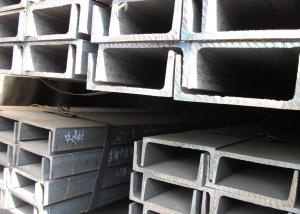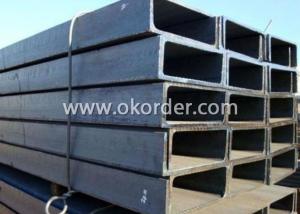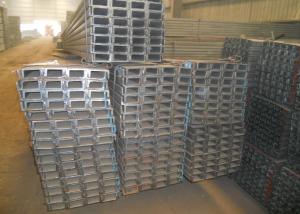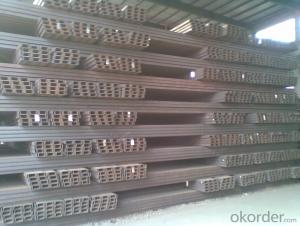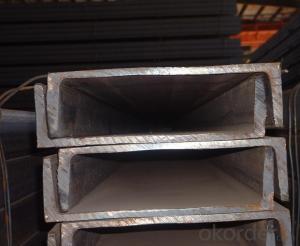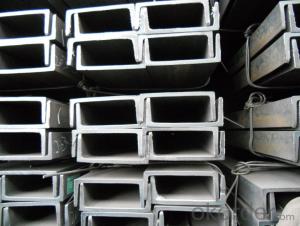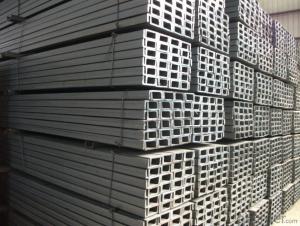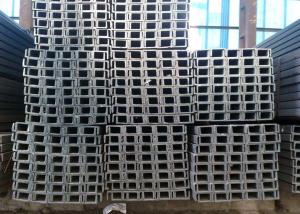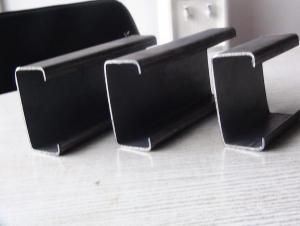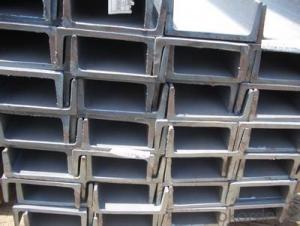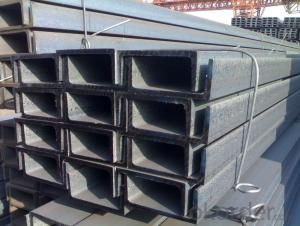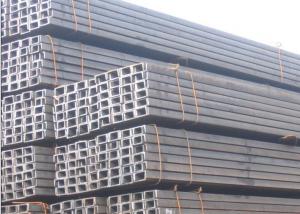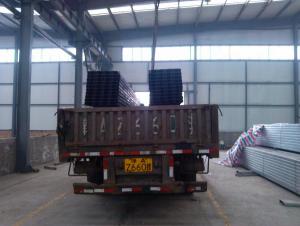U-Channels with Best Price Source from China Market
- Loading Port:
- Tianjin
- Payment Terms:
- TT OR LC
- Min Order Qty:
- 25 m.t
- Supply Capability:
- 10000 m.t/month
OKorder Service Pledge
OKorder Financial Service
You Might Also Like
Specification
Okorder.com is a professional materials & equipment supplier & manufacturer, offers integrated one-stop services including real-time quoting and online cargo tracking. We are funded by CNBM Group, a Fortune 500 enterprise and the largest materials & equipment firm in China.
Product Applications:
The MS Channel can be applied to construction of warehouses, workshops, sport stadiums and car parks etc.The hot rolled channel steel belongs to carbon structural steel which is applied to in the field of construction and machinery.In details, the hot rolled channel steel is usually used for arch-itechtural structure, and they could be welded in order to support or hang a vari-ety of facilities. They are also usually used in combination with I beam. Generally,the hot rolled channel steel we supply must possess perfect welding property, riveting property and mechanical property and so on.
Product Advantages:
OKorder's Steel U-Channels are durable, strong, and resist corrosion.
Main Product Features:
· Premium quality
· Prompt delivery & seaworthy packing (30 days after receiving deposit)
· Corrosion resistance
· Can be recycled and reused
· Mill test certification
· Professional Service
· Competitive pricing
Product Specifications:
1.We supply high quality MS Channel at reasonable price, including Chinese standard, Japanese standard and so on.
Standard | GB/JIS |
Material Grade | Q235,SS400 |
Technique: | Hot Rolled |
Sizes as per chinese standard: | 50*37*4.5mm - 300*89*11.5mm |
Sizes as per japanese standard: | 50*25*3mm – 200*80*7.5mm |
Length: | 6meter, 9meter, 12meter |
Note: 1.we are also competent to provide our customers other MS Channel based on other sizes according to customer’s requirements.
2. The length of our ms channel could be cut into other meters as per customer’s requirements. For example, the channel in 6meters could be cut into 5.8meters in order to be fit in the 20ft container.
2. The detailed sections of MS Channel as per GB standard.are shown in the table-1:
GB U CHANNEL | Standard | Sectional | Dimension |
| Mass: |
(mm) | (mm) | (mm) | (mm) | ||
50X37 | 50 | 37 | 4.50 | 7.0 | 5.438 |
63X40 | 63 | 40 | 4.80 | 7.5 | 6.634 |
80x43 | 80 | 43 | 5.00 | 8.0 | 8.045 |
100x48 | 100 | 48 | 5.30 | 8.5 | 10.007 |
120x53 | 120 | 53 | 5.50 | 9.0 | 12.059 |
140x58 | 140 | 58 | 6.00 | 9.5 | 14.535 |
140x60 | 140 | 60 | 8.00 | 9.5 | 16.733 |
160x63 | 160 | 63 | 6.50 | 10.0 | 17.240 |
160x65 | 160 | 65 | 8.50 | 10.0 | 19.752 |
180x68 | 180 | 68 | 7.00 | 10.5 | 20.174 |
180x70 | 180 | 70 | 9.00 | 10.5 | 23.000 |
200x73 | 200 | 73 | 7.00 | 11.0 | 22.637 |
200x75 | 200 | 75 | 9.00 | 11.0 | 25.777 |
220x77 | 220 | 77 | 7.00 | 11.5 | 24.999 |
220x79 | 220 | 79 | 9.00 | 11.5 | 28.453 |
250x78 | 250 | 78 | 7.00 | 12.0 | 27.410 |
250x80 | 250 | 80 | 9.00 | 12.0 | 31.335 |
250x82 | 250 | 82 | 11.00 | 12.0 | 35.260 |
280x82 | 280 | 82 | 7.50 | 12.5 | 31.427 |
280x84 | 280 | 84 | 9.50 | 12.5 | 35.823 |
280x86 | 280 | 86 | 11.50 | 12.5 | 40.219 |
300x85 | 300 | 85 | 7.50 | 13.5 | 34.463 |
300x87 | 300 | 87 | 9.50 | 13.5 | 39.173 |
300x89 | 300 | 89 | 11.50 | 13.5 | 43.883 |
Table-1
FAQ:
Q1: Why buy Materials & Equipment from OKorder.com?
A1: All products are carefully selected from China's most reliable manufacturing enterprises. Through its ISO certifications, OKorder.com adheres to the highest standards and a commitment to supply chain safety and customer satisfaction. We can guarantee the quality!
Q2: The products are invoicing on theoretical weight or on actual weight?
A2: We can do it in both manners, it’s according to buyer's requirement.
Q3: Can you offer the third part inspection certificates ?
A3: We are able to present our customers relevant SGS test report for mechanical property of MS Channel as customer’s request.
Images:
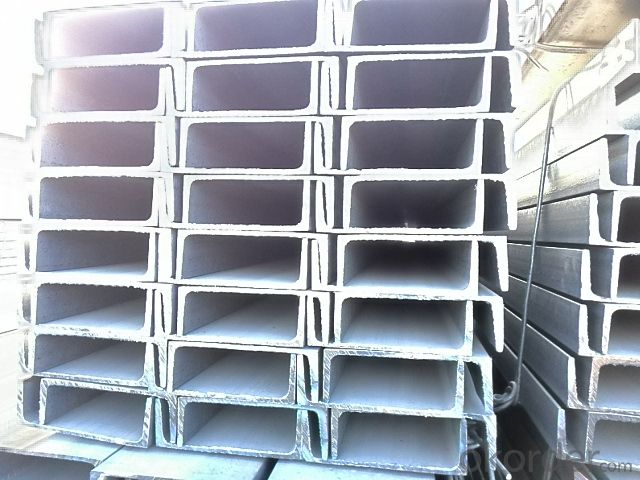
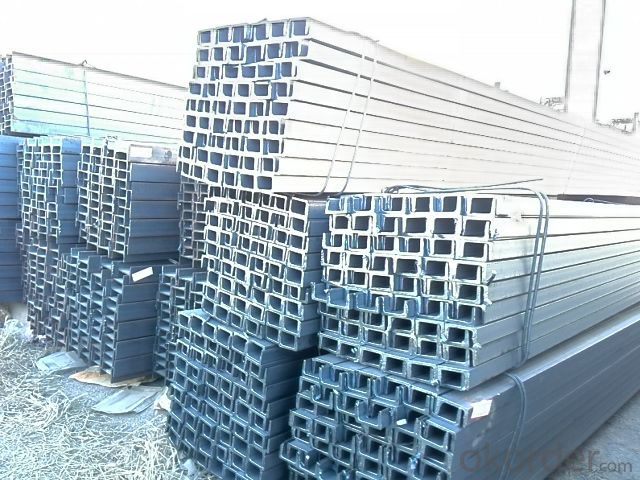
- Q: Can steel channels be used in the aerospace parts manufacturing industry?
- Yes, steel channels can be used in the aerospace parts manufacturing industry. Steel channels are often used in the construction of aircraft structures and components due to their high strength, durability, and resistance to deformation. They can be used in various applications such as framing, support structures, and reinforcement for critical aerospace parts. Steel channels provide structural integrity and stability, allowing for the safe and reliable operation of aerospace vehicles. Additionally, steel channels can be easily fabricated and welded, making them an ideal choice for the aerospace industry, where precision and quality are of utmost importance.
- Q: How is a steel channel made?
- Hot rolling is the typical method used to produce a steel channel. The process commences by heating a large rectangular steel billet until it reaches a malleable temperature. Subsequently, the billet is passed through a sequence of rollers that gradually transform it into the desired channel shape. Throughout the hot rolling process, the rollers continually squeeze and elongate the billet, resulting in a reduction in thickness and an increase in length. The final shape of the channel is determined by the grooves on the rollers. The channel section can range from a simple C-shape to more intricate U-shapes or even customized profiles. As the billet takes shape, any surplus material is expelled through the sides, leaving behind a well-defined and clean channel shape. To prevent warping or distortion during the rolling process, the channel is consistently cooled. Once the desired length is attained, the channel is cut into individual pieces according to the specific requirements of the customer. Following the hot rolling process, additional treatments may be applied to the steel channels, such as straightening, surface cleaning, or coating. These treatments ensure that the channels meet the desired specifications and are ready for use in various applications, including structural support, construction, and manufacturing. In summary, the hot rolling process plays a vital role in the production of steel channels, enabling the fabrication of sturdy and adaptable structural components that find application in multiple industries.
- Q: What are the different design codes for steel channels?
- Steel channels are commonly designed using various design codes to ensure their structural integrity and safety. Some widely used design codes for steel channels are: 1. The AISC Code, also known as the AISC Steel Construction Manual, offers comprehensive guidelines for designing steel structures, including channels. It covers design loads, material properties, design considerations, and connection details. 2. The Eurocode is a set of European standards for designing structures, including steel channels. Eurocode 3 focuses specifically on designing steel structures and provides guidelines for designing structural steel members, including channels. 3. British Standards (BS) provide design guidelines for various aspects of construction, including steel structures. In the UK, the main standard for designing steel channels is BS EN 1993-1-1, which incorporates the Eurocode for steel structure design. 4. The CSA S16 code provides guidelines for designing steel structures in Canada, including channels. It covers design principles, material specifications, and various design considerations for steel structures. 5. The AS/NZS 4100 code provides guidelines for designing steel structures in Australia and New Zealand. It covers material specifications, design principles, and design considerations specific to the region. These design codes ensure that steel channels are designed to withstand the intended loads, maintain stability, and comply with safety standards. When designing steel channels for construction projects, it is important to consult the relevant design code and adhere to local regulations.
- Q: What are the different types of surface treatments for steel channels in marine applications?
- There are several different types of surface treatments for steel channels used in marine applications. These treatments are designed to enhance the durability and corrosion resistance of the steel in harsh marine environments. One common surface treatment is hot-dip galvanizing. In this process, the steel channel is dipped into a bath of molten zinc, which forms a protective coating on the surface. This coating acts as a barrier against corrosion, protecting the steel from the corrosive effects of saltwater and other marine elements. Another option is epoxy coating. This involves applying a layer of epoxy paint to the surface of the steel channel. The epoxy creates a protective barrier, preventing water and oxygen from reaching the steel and causing corrosion. Epoxy coatings can be particularly effective in marine environments where there is a high risk of abrasion or impact. In addition to galvanizing and epoxy coating, there are also other surface treatments available for steel channels in marine applications. These include metalizing, which involves spraying molten metal onto the surface of the steel to provide a protective coating, and electroplating, which involves depositing a layer of metal onto the surface of the steel using an electric current. Furthermore, some manufacturers offer specialized marine coatings that are specifically formulated to withstand the unique challenges of marine environments. These coatings may contain additives or compounds that provide enhanced corrosion resistance and durability. Ultimately, the choice of surface treatment for steel channels in marine applications will depend on factors such as the specific environment, the level of corrosion resistance required, and the budget. It is important to consult with a corrosion specialist or an engineer to determine the most suitable surface treatment for a particular marine application.
- Q: A solar roof concrete foundation steel embedded parts, steel embedded parts are welded on the welding channel, two channel to head to head up, ask whether the welding part of a steel plate welding lining need? Or what other requirements? What norms do these requirements come from? Thank you
- Butt welding, full welding, through the groove just fine! What about steel plates? No way, single-sided welding, double-sided molding
- Q: What is the difference between channel steel and C steel?
- Channel steel is rail steel, relatively thick. C steel is rolled by iron plate
- Q: What are the different load combinations considered for steel channels?
- The load combinations considered for steel channels depend on the specific application and design requirements. The typical load combinations for steel channels include dead loads, live loads, wind loads, seismic loads, and other applicable loads. Dead loads are the permanent or static loads that constantly act on the structure. They include the self-weight of the steel channel, fixtures, and any other permanent elements attached to it. On the other hand, live loads are variable loads that do not permanently act on the structure. They can include people, furniture, equipment, or other movable loads. Wind loads are important for structures exposed to wind. They take into account the pressure and suction forces exerted by the wind on the steel channel. Seismic loads, or earthquake loads, are considered in areas prone to seismic activity. They account for the horizontal and vertical forces generated during an earthquake. Besides these primary load types, other loads like snow loads, dynamic loads, impact loads, and thermal loads may also need to be considered. This depends on the specific design requirements and intended use of the steel channel. Engineers typically refer to relevant building codes, standards, and design guidelines to determine the appropriate load combinations. These codes and standards provide guidance on load combinations for different applications and regions. They ensure that the steel channel is designed to safely carry the expected loads without failure or excessive deformation.
- Q: Could you tell me the theoretical weight and size of 16 and 18 channel steel?
- Channel steel 16#a specifications 160x, 63x, 6.5mm, theoretical weight of 17.24 kg per meterChannel steel 16#b specifications 160x 65 8.5mm, theoretical weight of 19.752 kg per meterChannel steel 18#a specifications 180X, 68x 7 mm, theoretical weight of 20.174 kg per meterChannel steel 18#b specifications 180 X70 x9mm, theoretical weight of 23 kg per meter
- Q: What are the different types of corrosion protection for steel channels?
- There are several different types of corrosion protection methods available for steel channels, depending on the specific requirements and environmental conditions. Some of the common methods are: 1. Galvanization: This is one of the most popular methods of corrosion protection for steel channels. In this process, the channels are coated with a layer of zinc, which acts as a sacrificial anode and prevents corrosion by corroding itself instead of the steel. 2. Powder coating: Powder coating involves applying a dry powder to the channels and then baking it in an oven to create a protective layer. This method provides excellent corrosion resistance and can also enhance the aesthetics of the channels. 3. Epoxy coatings: Epoxy coatings are commonly used for corrosion protection in aggressive environments. These coatings form a strong and durable barrier against moisture and chemical exposure, preventing the steel channels from corroding. 4. Paint coatings: Paint coatings can provide a cost-effective solution for corrosion protection. Multiple layers of paint are applied to the steel channels, creating a barrier between the metal and the corrosive elements in the environment. 5. Hot-dip galvanizing: Similar to galvanization, hot-dip galvanizing involves immersing the steel channels in a bath of molten zinc. This process provides a thicker and more durable layer of protection compared to regular galvanization. 6. Cathodic protection: Cathodic protection is a technique used to protect steel channels by making them the cathode in a corrosion cell. This is achieved by connecting the channels to a sacrificial anode, such as zinc or magnesium, which corrodes instead of the steel. 7. Stainless steel: Using stainless steel channels is another effective way to prevent corrosion. Stainless steel contains a high percentage of chromium, which forms a passive oxide layer on the surface, protecting it from corrosion. It is important to choose the appropriate corrosion protection method based on factors such as the environment, expected lifespan, and cost considerations to ensure the longevity and durability of steel channels.
- Q: How do steel channels perform in terms of thermal insulation?
- Steel channels do not perform well in terms of thermal insulation. Steel is a good conductor of heat, so steel channels tend to transfer heat easily. Consequently, they are not effective in providing insulation against heat transfer.
Send your message to us
U-Channels with Best Price Source from China Market
- Loading Port:
- Tianjin
- Payment Terms:
- TT OR LC
- Min Order Qty:
- 25 m.t
- Supply Capability:
- 10000 m.t/month
OKorder Service Pledge
OKorder Financial Service
Similar products
Hot products
Hot Searches
Related keywords
